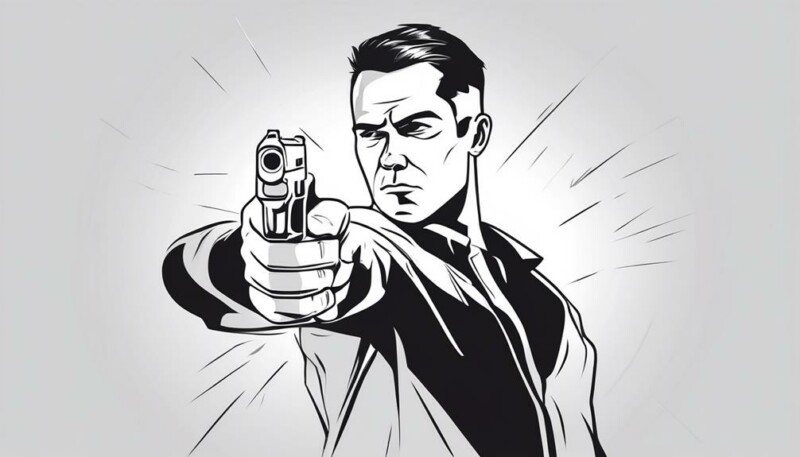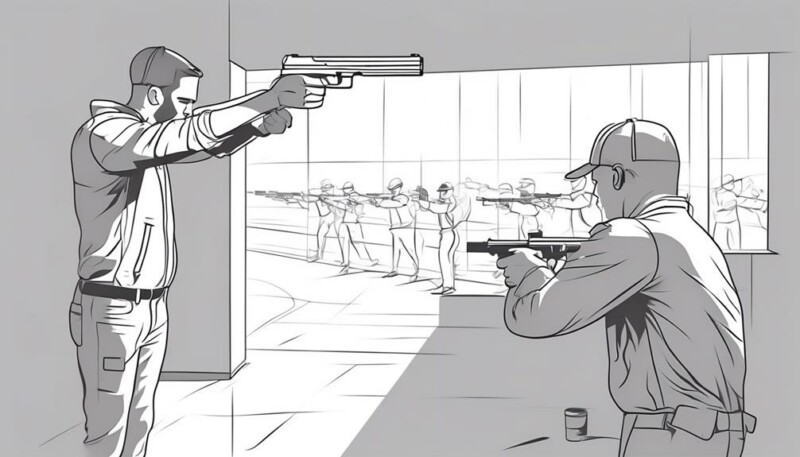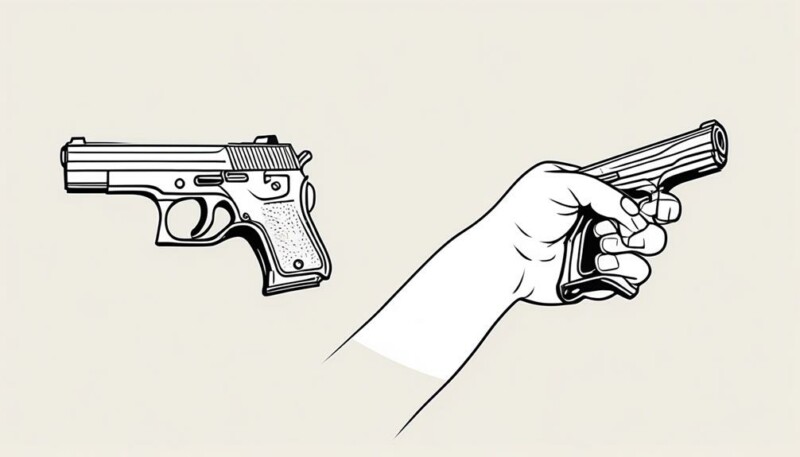Did you know that carrying a concealed firearm for self-defense requires more than just purchasing a gun and sticking it in your pocket? If you're new to concealed carry, it's essential to understand the top beginner tips for safe practices.
From choosing the right holster to understanding state laws and developing a safety mindset, there are several factors to consider.
In this discussion, we will explore some key tips that will help you navigate the world of concealed carry with confidence and ensure your safety. So, let's dive in and discover the essential practices that every beginner should know to carry responsibly and effectively.
Key Takeaways
- Consider your specific needs, preferences, and body type when selecting a holster.
- Always practice safe firearm handling and develop a safety mindset.
- Understand and comply with the state laws and regulations regarding concealed carry permits.
- Regularly train and practice drills to maintain skills and proficiency with your firearm.
Holster Selection
When selecting a holster for concealed carry, it's important to consider your specific needs, preferences, and body type to ensure a safe and comfortable carrying experience.
Research different types of holsters, such as inside-the-waistband or appendix carry, to find the one that suits your needs.
Opt for a holster that allows for easy concealment, so you can carry your firearm discreetly.
Choose a subtle holster that suits your needs, style, and attire to avoid drawing attention to your firearm.
Investing in a high-quality holster is crucial for both firearms safety and carrying a firearm effectively. Look for a holster that's durable and provides proper retention for your handgun.
Additionally, consider factors such as your body type, clothing style, and physical characteristics when selecting a holster.
Attending a concealed carry class can also provide valuable insights and guidance on choosing the right holster for your specific needs.
Proper Firearm Handling

To ensure the safety and proper handling of your firearm, it is essential to follow a set of guidelines and practices. Proper firearm handling is crucial when carrying a concealed handgun. By adhering to these tips, you can minimize the risk of accidents and ensure the responsible use of your firearm.
One of the most important rules of firearm handling is always keeping the firearm pointed in a safe direction. This means directing it away from people and never pointing it at anything you do not intend to shoot. Additionally, it is crucial to keep your finger off the trigger until you are ready to fire. This ensures that the firearm remains safe and prevents accidental discharges.
Treating every firearm as if it is loaded, regardless of whether you believe it is or not, is another fundamental principle. By following this rule, you will consistently practice safe handling techniques. Furthermore, it is essential to be aware of your target and what is beyond it. This means having a clear line of sight and understanding what lies behind your intended target.
To engage you further, here is a table highlighting some key principles of proper firearm handling:
| Proper Firearm Handling Principles |
|---|
| Always keep the firearm pointed in a safe direction |
| Keep your finger off the trigger until you are ready to fire |
| Treat every firearm as if it is loaded |
| Be aware of your target and what is beyond it |
Concealment Techniques
After ensuring the safety and proper handling of your firearm, it's important to master effective concealment techniques to maintain a low profile while carrying a concealed handgun. Here are some tips to help you conceal your firearm discreetly and safely:
- Choose the right holster: Select a subtle holster that suits your needs, style, and attire. This will help avoid drawing attention to your firearm and ensure it stays securely in place.
- Practice drawing from your holster: Regularly practice drawing your firearm from the holster to ensure you can do so quickly and efficiently in an emergency situation. This will help build muscle memory and improve your response time.
- Know the laws and regulations: Familiarize yourself with the laws and regulations regarding concealed carry in your state. This will help you avoid legal complications and ensure you're carrying responsibly and within the boundaries of the law.
- Continuous training: Stay proactive in your training and education on firearm safety and best practices. Attend classes, seek professional instruction, and stay updated on the latest techniques and laws pertaining to concealed carry.
Understanding State Laws

To ensure compliance with concealed carry laws, it's crucial that you research and understand the specific regulations in your state. This includes familiarizing yourself with rules regarding carrying firearms in public places, drawing your firearm, and alcohol consumption.
Additionally, be aware of any restrictions or requirements for obtaining permits or licenses for concealed carry. Stay updated on any changes to the laws and consult with legal professionals or law enforcement if you have any doubts or questions.
State-Specific Regulations
To safely navigate concealed carry laws, it's crucial to have a comprehensive understanding of the specific regulations in your state. Each state has its own laws regarding concealed carry handguns, and it's important to know and abide by them to stay on the right side of the law. Here are four key points to keep in mind when it comes to state-specific regulations:
- Research and understand the laws in your state: Take the time to thoroughly research and familiarize yourself with the concealed carry laws in your state. This includes knowing the requirements for obtaining permits or licenses, as well as any restrictions or limitations.
- Know where you can and can't carry: State laws may vary in terms of where you're allowed to carry your firearm. It's essential to know the specific locations where carrying a concealed handgun is prohibited, such as government buildings or schools.
- Stay updated on changes: Laws can change over time, so it's important to stay informed about any updates or revisions to the concealed carry laws in your state. This can be done by regularly checking official government websites or consulting with legal professionals.
- Seek clarification when needed: If you have any doubts or questions about the laws in your state, it's advisable to seek clarification from legal professionals or law enforcement officers. They can provide guidance and help you navigate through any confusing aspects of the regulations.
Concealed Carry Permits
Before applying for a concealed carry permit, it is crucial to thoroughly understand the specific laws and regulations in your state. Each state has its own set of guidelines and requirements for obtaining a concealed carry permit. To make it easier for you, here is a table summarizing some key points to consider when applying for a concealed carry permit:
| State | Training Requirements | Prohibited Locations | Alcohol Consumption |
|---|---|---|---|
| State A | 8-hour course | Schools, government buildings | Not allowed while carrying |
| State B | 16-hour course | Schools, hospitals | Not allowed while carrying |
| State C | No training required | Government buildings | Allowed, but not while carrying |
| State D | 4-hour course | Schools, bars | Allowed, but not while carrying |
| State E | 12-hour course | Government buildings, public parks | Allowed, but not while carrying |
Remember to stay updated on any changes or updates to the concealed carry laws in your state. If you have any doubts or questions, it is always best to consult legal professionals or law enforcement officers for clarification. Understanding and adhering to your state's firearm laws will ensure that you are carrying your gun responsibly and within the bounds of the law.
Continuous Training and Practice

To ensure your safety and effectiveness as a concealed carrier, it's crucial to prioritize continuous training and practice.
Regularly honing your skills through firearm training and consistent practice drills will help build muscle memory and improve split-second decision-making in self-defense situations.
Regular Firearm Training
Regular firearm training is essential for improving accuracy, enhancing decision-making skills, and maintaining muscle memory for quick and effective firearm deployment. To make the most out of your training sessions, consider the following tips:
- Practice drawing: Incorporate drawing your firearm from its holster into your training routine. This will help you develop the necessary speed and dexterity for real-life situations.
- Dress appropriately: Train while wearing the clothing and accessories that you typically wear when carrying concealed. This will ensure that you're accustomed to drawing and shooting with your concealed carry setup.
- Choose the right holster: Invest in a high-quality holster that fits securely and comfortably. Practice drawing and reholstering your firearm with your chosen holster to ensure smooth and reliable performance.
- Know the laws in your area: Stay up-to-date with the laws and regulations regarding concealed carry in your jurisdiction. This knowledge will help you make informed decisions during training and in real-life scenarios.
Consistent Practice Drills
In order to consistently improve your concealed carry skills, it's crucial to incorporate regular practice drills into your training routine.
One of the first orders of business is to practice your holster draw regularly. This helps build muscle memory and enhances split-second decision-making in high-pressure situations. Make sure to consistently holster your firearm in the same position, as this ensures muscle memory and consistency in drawing.
Additionally, it's essential to regularly practice drawing and firing at the shooting range. This simulates life-threatening situations and enhances your skills. Continuous training and practice are necessary to ensure you can draw and fire your gun without hesitation when necessary.
Taking the time to repeatedly practice holster draw with an unloaded firearm at home can also improve your readiness and reaction time.
Ongoing Skill Development
Developing and maintaining your skills as a concealed carrier requires ongoing training and practice. Here are four key aspects to consider for your ongoing skill development:
- Regular practice: Engage in consistent practice to maintain proficiency in handling and using your firearm. Find a private and safe location where you can practice your draw, aim, and shooting techniques.
- Seek professional training: To continuously improve your skills and knowledge, seek out professional training and education opportunities. These courses can provide valuable insights and guidance on carrying concealed, as well as help you develop proper techniques and situational awareness.
- Evaluate your setup: Regularly reassess your concealed carry setup for effectiveness. Make necessary adjustments to ensure comfort, accessibility, and retention of your firearm. This could involve trying different holsters, belts, or clothing options.
- Embrace lifelong learning: Adopt a mindset of continuous learning and responsibility as a concealed carrier. Stay updated on best practices, techniques, and legal regulations. Read books, attend seminars, and engage with the concealed carry community to expand your knowledge and skills.
Developing a Safety Mindset

Maintain a constant state of vigilance and prioritize safe handling by always treating your firearm as if it is loaded and ready to fire. Developing a safety mindset is crucial when it comes to concealed carry practices. By keeping your finger off the trigger until you are ready to shoot, you can prevent accidental discharge and ensure safe handling of your handgun. Paying attention to your surroundings is equally important. Being aware of potential threats and making necessary adjustments to your actions and environment can help you stay prepared for any situation that may arise. To further enhance your safety mindset, engage in scenario-based training regularly. This type of training allows you to practice decision-making and situational awareness in various self-defense scenarios. Additionally, it is essential to continuously educate yourself on self-defense laws and regulations to ensure that you are practicing legal and responsible concealed carry. By developing a safety mindset, you not only protect yourself but also minimize the risk of unnecessary attention when carrying a firearm in public.
| Concealed Carry Tips |
|---|
| Always treat your firearm as if it is loaded and ready to fire. |
| Keep your finger off the trigger until you are ready to shoot. |
| Maintain a heightened awareness of your surroundings. |
| Engage in scenario-based training regularly. |
| Continuously educate yourself on self-defense laws. |
Frequently Asked Questions
What Is the Best Safety for Concealed Carry?
The best safety for concealed carry is a proper holster. It ensures that your firearm is securely and safely stored, preventing accidental discharges.
In addition, practicing trigger discipline is crucial to avoid any unintended firing. Consider taking training courses to enhance your skills and knowledge.
Holster retention is also important to prevent someone from taking your weapon.
Mental preparedness, situational awareness, and regular maintenance are key to being a responsible concealed carrier.
What Every New Gun Owner Should Know?
As a new gun owner, it's important to know about:
- Proper grip
- Trigger control
- Holster selection
- Gun storage
- Firearm maintenance
Understanding these topics will help you carry your firearm responsibly and safely.
It's also crucial to be aware of:
- Situational awareness
- Legal considerations
- Training resources
Keep in mind the legal restrictions and where you can carry a concealed firearm. Practice your holster draw regularly to build muscle memory and decision-making skills.
Stay informed about local gun laws and regulations. And always prioritize safety above all else.
What Is the Most Effective Position for Concealed Carry?
The most effective position for concealed carry depends on various factors such as your body type, clothing choices, and personal preferences.
It's crucial to find an optimal holster that provides secure retention and proper concealment of your firearm.
Experiment with different concealed carry positions to determine what offers the best combination of comfort and accessibility for you.
Additionally, consider concealment techniques and practice drawing from concealment to ensure quick and efficient access to your firearm in emergency situations.
What Do You Wear When Concealed Carrying?
When concealed carrying, it's important to consider your clothing choices. Opt for clothing that allows for discreet and comfortable firearm concealment. Choose a proper holster that securely holds your firearm.
For women, concealed carry purses and undergarment options are available. Additionally, concealed carry belts and accessories can help with comfort and accessibility.
It's crucial to choose the right size firearm that can be easily concealed. Lastly, be mindful of the weather conditions and adjust your clothing accordingly to maintain proper concealment.
Conclusion
In the journey of concealed carry, remember that your firearm isn't just a tool, but a responsibility. Like a compass guiding you through uncharted territories, your knowledge, practice, and adherence to safety measures will be your guiding star.
As you navigate the path of self-defense, let the allegory of your concealed carry journey inspire you to continuously seek wisdom, train diligently, and always prioritize the safety of yourself and others.
Stay vigilant, stay prepared, and may your concealed carry practices always be safe and secure.
